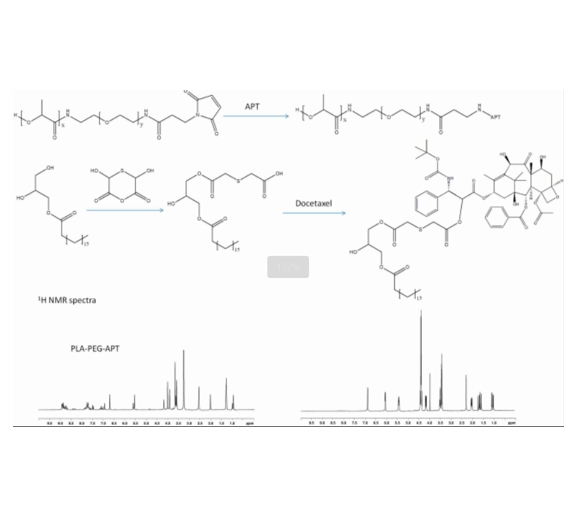文献:
Combination Chemotherapy of Lung Cancer–Co-Delivery of Docetaxel Prodrug and Cisplatin Using Aptamer-Decorated Lipid–Polymer Hybrid Nanoparticles
文献链接:
https://pubmed.ncbi.nlm.nih.gov/32606595/作者:
Ruifeng Wu,Zhiqiang Zhang,Baohua Wang,Ge Chen,Yaozhong Zhang,Haowen Deng,Zilong Tang,Junjie Mao,Lei Wang
相关产品:
FITC-PLA-PEG-MAL(荧光素-聚乳酸-聚乙二醇-马来酰亚胺)
原文摘要:
Lung cancer is the leading cause of cancer mortality worldwide. Drug resistance is the major barrier for the treatment of non-small cell lung cancer (NSCLC). The aim of this research is to develop an aptamer-decorated hybrid nanoparticle for the co-delivery of docetaxel prodrug (DTXp) and cisplatin (DDP) and to treat lung cancer. Materials and Methods: Aptamer-conjugated lipid-polymer ligands and redox-sensitive docetaxel prodrug were synthesized. DTXp and DDP were loaded into the lipid–polymer hybrid nanoparticles (LPHNs). The targeted efficiency of aptamer-decorated, DTXp and DDP co-encapsulated LPHNs (APT-DTXp/DDP-LPHNs) was determined by performing a cell uptake assay by flow cytometry-based analysis. In vivo biodistribution and anticancer efficiency of APT-DTXp/DDP-LPHNs were evaluated on NSCLC-bearing mice xenograft. Results: APT-DTXp/DDP-LPHNs had a particle size of 213.5 ± 5.3 nm, with a zeta potential of 15.9 ± 1.9 mV. APT-DTXp/DDP-LPHNs exhibited a significantly enhanced cytotoxicity (drug concentration causing 50% inhibition was 0.71 ± 0.09 μg/mL), synergy antitumor effect (combination index was 0.62), and profound tumor inhibition ability (tumor inhibition ratio of 81.4%) compared with the non-aptamer-decorated LPHNs and single drugloaded LPHNs. Conclusion: Since the synergistic effect of the drugs was found in this system, it would have great potential to inhibit lung tumor cells and in vivo tumor growth.
PLA-PEG-MAL,即聚乳酸-聚乙二醇-马来酰亚胺,是一种具有生物相容性和生物降解性的嵌段共聚物。PLA-PEG-MAL由聚乳酸(PLA)、聚乙二醇(PEG)和马来酰亚胺(MAL)三种组分构成。其中,MAL基团具有较强的反应活性,可以与含有氨基(-NH2)或巯基(-SH)的生物分子发生反应,形成稳定的连接。由于PLA-PEG-MAL具有的这些良好性质所以应用方向也很广,小编引用的这篇文献中就介绍了在适配体修饰的混合纳米颗粒的应用,具体制备过程如下:
通过将适配体与PLA-PEG-Mal结合,合成了与适配体结合的脂质聚合物配体。将PLA-PEG-MAL溶解于PBS中。然后,将S6适配体与溶液混合,然后用透析膜用蒸馏水透析,冻干得到适配体偶联的PLA-PEG(PLA-PEG-APT),并在4°C下备用。
多西他赛(DTX)氧化还原敏感型前药(DTXp)是通过使用氧化还原响应型硫代二乙酸酐(TA)将多西他赛(DTX)与单硬脂酸甘油酯(GM)偶联合成。将GM溶于氯仿,然后加入EDC和HOBt,搅拌以活化TA的羧基。之后,加入TA,在室温下搅拌反应,得到GM-TA。接着向GM-TA中加入DTX、EDC和HOBt。然后将溶液温度降温,在氮气保护下搅拌。之后,在室温下搅拌反应,得到DTX-GM-TA。最后,将所得产物进行冷冻干燥,获得最终产物,并储存于4°C条件下,以备后续使用。

图: PLA-PEG-APT和DTX-GM-TA的合成
为评估脂质体-聚合物杂化纳米粒(LPHNs)的细胞摄取效率,将荧光染料(FITC)应用于LPHNs系统。在制备过程中,使用FITC-PLA-PEG-MAL代替PLA-PEG-MAL。将A549细胞和BEAS2B细胞接种于培养板中;然后,向每孔中加入含有LPHNs的无血清RPMI 1640培养基。孵育后,用冷PBS洗涤细胞。使用流式细胞仪测定细胞的荧光强度。

图:APT-DTXp/DDP-LPHNs和DTXp/DDP-LPHNs的TEM图像
结论:
PLA-PEG-MAL可用作化合物传递系统的载体。其MAL基团能与化合物分子进行共价结合,实现化合物的稳定载体化和靶向输送。通过调节PLA、PEG和MAL之间的配比和分子量,可以改变化合物的缓释和转运行为,从而提高的生物利用度和靶向性。DTXp和DDP被载入lphn中。与适配体修饰和单药LPHNs相比,APT-DTXp/DDPLPHNs具有明显的细胞poison性、协同抗tumour作用、较强的tumour抑制能力。APTDTXp/DDP-LPHNs具有抑制肺tumour细胞和体内tumour生长的潜力。

 2024-12-18 作者:ws 来源:
2024-12-18 作者:ws 来源:

